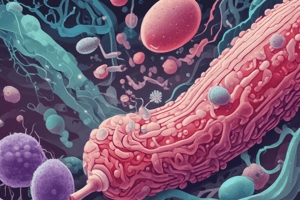Podcast
Questions and Answers
What is the mechanism of resistance to beta-lactam antibiotics?
What is the mechanism of resistance to beta-lactam antibiotics?
- Efflux pumps
- Enzymatic inactivation (correct)
- Production of aminoglycoside inactivating enzyme
- Alteration of target site
What is the result of the acquisition of mecA gene in MRSA?
What is the result of the acquisition of mecA gene in MRSA?
- Alteration of target site
- PBP2a with high affinity for β-lactams
- Production of aminoglycoside inactivating enzyme
- PBP2a with low affinity for β-lactams (correct)
What is the mechanism of vancomycin resistance?
What is the mechanism of vancomycin resistance?
- Enzymatic inactivation
- Efflux pumps
- Production of aminoglycoside inactivating enzyme
- Alteration of target site (correct)
What is the effect of efflux pumps on bacterial resistance?
What is the effect of efflux pumps on bacterial resistance?
What is the consequence of antibiotic resistance on healthcare costs?
What is the consequence of antibiotic resistance on healthcare costs?
What is a common misuse of antibiotics?
What is a common misuse of antibiotics?
What is the effect of antibiotic resistance on morbidity?
What is the effect of antibiotic resistance on morbidity?
What is the mechanism of resistance to quinolone antibiotics?
What is the mechanism of resistance to quinolone antibiotics?
What is antimicrobial resistance?
What is antimicrobial resistance?
What type of resistance is due to bacterial structural or functional features?
What type of resistance is due to bacterial structural or functional features?
What is an example of intrinsic resistance?
What is an example of intrinsic resistance?
What is the mechanism of acquired resistance?
What is the mechanism of acquired resistance?
What is cross resistance?
What is cross resistance?
What is multiple drug resistance (MDR)?
What is multiple drug resistance (MDR)?
What is an example of intrinsic resistance to metronidazole?
What is an example of intrinsic resistance to metronidazole?
What is the main reason for the emergence of antibiotic resistance?
What is the main reason for the emergence of antibiotic resistance?
What is the mechanism of action of azoles?
What is the mechanism of action of azoles?
What is the effect of azoles on fungal cells?
What is the effect of azoles on fungal cells?
Which azole is used to treat Candida albicans?
Which azole is used to treat Candida albicans?
What is a characteristic of triazole drugs?
What is a characteristic of triazole drugs?
Why is itraconazole more frequently associated with liver toxicity?
Why is itraconazole more frequently associated with liver toxicity?
What is a characteristic of imidazole azoles?
What is a characteristic of imidazole azoles?
Why is fluconazole better absorbed from the GIT than itraconazole?
Why is fluconazole better absorbed from the GIT than itraconazole?
What is a characteristic of topical azole products?
What is a characteristic of topical azole products?
What is one mechanism of resistance where the drug is destroyed?
What is one mechanism of resistance where the drug is destroyed?
Which type of antibiotics is affected by β-lactamases?
Which type of antibiotics is affected by β-lactamases?
What is the result of modification of the target site?
What is the result of modification of the target site?
Which of the following is NOT a mechanism of resistance?
Which of the following is NOT a mechanism of resistance?
What is the result of production of inactivating enzymes?
What is the result of production of inactivating enzymes?
Which enzyme is responsible for inactivating aminoglycosides?
Which enzyme is responsible for inactivating aminoglycosides?
What is the result of increased efflux?
What is the result of increased efflux?
What is an example of a bacterium that exhibits methicillin resistance?
What is an example of a bacterium that exhibits methicillin resistance?
What is the purpose of using Anidulafungin and Micafungin?
What is the purpose of using Anidulafungin and Micafungin?
How is Flucytosine absorbed into fungal cells?
How is Flucytosine absorbed into fungal cells?
What is the effect of Flucytosine on fungal cells?
What is the effect of Flucytosine on fungal cells?
What is the use of Flucytosine?
What is the use of Flucytosine?
What is the mechanism of action of Griseofulvin?
What is the mechanism of action of Griseofulvin?
What is the use of Griseofulvin?
What is the use of Griseofulvin?
Flashcards
Antimicrobial Resistance
Antimicrobial Resistance
Microorganisms' ability to survive and reproduce in the presence of antimicrobial agents that were previously effective.
Intrinsic Resistance
Intrinsic Resistance
Naturally occurring resistance due to bacterial features, specific to species or genus.
Acquired Resistance
Acquired Resistance
Resistance that develops in certain strains through mutations or gene transfer.
Drug Modification
Drug Modification
Signup and view all the flashcards
Target Alteration
Target Alteration
Signup and view all the flashcards
Reduced Cellular Uptake
Reduced Cellular Uptake
Signup and view all the flashcards
Increased Efflux
Increased Efflux
Signup and view all the flashcards
Over-Prescribing Antibiotics
Over-Prescribing Antibiotics
Signup and view all the flashcards
Prolonged Prophylactic Therapy
Prolonged Prophylactic Therapy
Signup and view all the flashcards
Azoles Mechanism of Action
Azoles Mechanism of Action
Signup and view all the flashcards
Azoles Inhibit 14-alpha Demethylase
Azoles Inhibit 14-alpha Demethylase
Signup and view all the flashcards
Azoles Toxic Sterol Accumulation
Azoles Toxic Sterol Accumulation
Signup and view all the flashcards
Azoles Increased Membrane Permeability
Azoles Increased Membrane Permeability
Signup and view all the flashcards
Triazole Antifungal Drugs
Triazole Antifungal Drugs
Signup and view all the flashcards
Flucytosine Mechanism of Action
Flucytosine Mechanism of Action
Signup and view all the flashcards
Flucytosine Disrupts RNA Biosynthesis
Flucytosine Disrupts RNA Biosynthesis
Signup and view all the flashcards
Flucytosine Therapeutic Use
Flucytosine Therapeutic Use
Signup and view all the flashcards
Griseofulvin Mechanism of Action
Griseofulvin Mechanism of Action
Signup and view all the flashcards
Griseofulvin Inhibits Microtubule De-polymerization
Griseofulvin Inhibits Microtubule De-polymerization
Signup and view all the flashcards
Griseofulvin Inhibits Fungal Cell Replication
Griseofulvin Inhibits Fungal Cell Replication
Signup and view all the flashcards
Griseofulvin Therapeutic Use
Griseofulvin Therapeutic Use
Signup and view all the flashcards
Study Notes
Antimicrobial Resistance
- Antimicrobial resistance is the ability of microorganisms to survive and reproduce in the presence of antimicrobial agents that were previously thought to be effective against them.
Classification of Antibiotic Resistance
- Intrinsic resistance: due to bacterial structural or functional features, naturally occurring, species or genus specific.
- Examples: Gram-negative bacteria are intrinsically resistant to vancomycin, aerobic bacteria are intrinsically resistant to metronidazole.
- Acquired resistance: can take place by two different mechanisms: mutations and horizontal gene transfer.
- Present only in certain strains of a species or genus.
Mechanisms of Resistance
- Modification of the drug: production of enzyme that destroys or deactivates drug.
- Examples: β-lactamases convert penicillins and cephalosporins into penicilloic and cephalosporic acids.
- Alteration of the target: alter target of drug so it binds less effectively.
- Example: methicillin resistance in S. aureus (MRSA) due to the acquisition of mecA gene encodes PBP2a, that has low affinity for all β-lactams.
- Reduced cellular uptake: slow or prevent entry of drug into the cell.
- Increased efflux: pump antimicrobial drug out of the cell before it can act.
Common Misuses of Antibiotics
- Over-prescribing of antibiotics.
- Prolonged prophylactic therapy.
- It is too toxic to be given by injection.
Mechanism of Action of Antifungal Drugs
Azoles
- Inhibit ergosterol synthesis by inhibiting the fungal cytochrome P-450 3-A dependent enzyme 14-alpha demethylase, blocking the demethylation of lanosterol to ergosterol.
- Accumulation of toxic intermediate sterols.
- Increased membrane permeability, cell death.
Triazoles
- Fluconazole, itraconazole, posaconazole
- All are orally active, except posaconazole, which is available in injection form.
Nucleic Acid Synthesis
- Flucytosine is absorbed into fungal cells via cytosine permease and converted to 5-fluorouracil, which interferes with fungal RNA biosynthesis.
- Used to treat systemic Candida spp. or Cryptococcus spp. infections.
Cell Mitosis
- Griseofulvin is a mitotic inhibitor that binds to polymerized fungal microtubules, inhibiting the de-polymerization, and leading to the failure of the fungal cell replication.
- Used to treat dermatophytoses of the skin, hair, and nails.
Studying That Suits You
Use AI to generate personalized quizzes and flashcards to suit your learning preferences.




